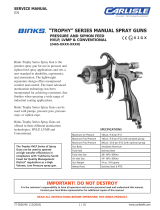
5. OPERATION
5.1. For best results, handle the gun correctly. It should be held perpendicular to the surface being sprayed and moved parallel to it. Start the
stroke before squeezing the trigger and release the trigger before finishing the stroke. This will give more accurate control of the gun and
the material (see right).
5.2. Spray from a distance of 6 (150mm) to 10 inches (250mm), depending on the material
and the atomizing pressure. The material deposited should always be even and wet. Each
stroke must overlap the preceding stroke to obtain a uniform finish. To reduce overspray
and obtain maximum efficiency, spray with the lowest possible atomizing air pressure.
5.3. Controlling the fluid and the fan spray:
a) As the width of the spray is altered so the fluid flow must be adjusted to maintain the
same coverage. Use the fluid control screw (‘C’ in Section 7).
b) The direction of the fan spray, either horizontal or vertical, is adjusted by turning the air
cap to the desired position and then tightening the retaining ring.
6. m MAINTENANCE/CLEANINGintenance
6.1. Disconnect from the air supply before attempting any maintenance
or cleaning. When reassembling after maintenance, be sure to
take care when screwing parts together. At first screw parts hand tight
to avoid cross-threading. If a part cannot easily be turned by hand, check that you have
the correct part, or unscrew, realign and try again. DO NOT use excessive force when
reassembling.
6.2. SPRAY GUN
6.2.1. Immerse the front end of the gun only in solvent until the solvent just covers
the fluid connection.
6.2.2. Use a bristle brush and solvent to wash off accumulated paint.
6.2.3. Do not immerse the entire gun in solvent. This will cause lubricants to dissolve and packing to dry out.
6.2.4. Dirty solvent may also clog the narrow passages in the gun.
6.2.5. Wipe the outside of the gun with a dampened solvent rag.
6.2.6. Lubricate the gun daily with a light machine oil. Be sure to lubricate the fluid needle packing, air valve
packing, side port control packing and trigger pivot point. Do not use lubricants containing silicone.
6.2.7. When finished spraying, flush the gun through with clean thinners.
6.3. AIR NOZZLE, FLUID NOZZLE & NEEDLE ASSEMBLY
6.3.1. To clean the nozzles, soak them in solvent to dissolve any dried material then blow them clean with air. Handle all nozzles carefully and
do not make any alterations in the gun.
6.3.2. If you need to probe the holes in the nozzles, be sure to use a tool that is softer than brass; do not use metal instruments.
6.3.3. Adjust the fluid needle valve so that when the gun is triggered, air flow occurs before fluid flow.
7. tm TROUBLESHOOTING
Original Language Version
© Jack Sealey Limited HVLP-79.V3 Issue:1 25/10/21
THE PROBLEM THE CAUSE THE SOLUTION
Heavy atomization, poor centre pattern Fluid flow is too high for
the air pressure and flow
1. Increase air pressure by adjusting
regulator (A) and increase flow
adjusting regulator (B).
2. Reduce paint flow with regulator (C).
3. Paint may be too thick. If so, dilute it.
Poor atomization/heavy centre pattern Air pressure and flow too high for fluid flow 1. Reduce air pressure by adjusting
regulator (A).
2. Reduce air flow by adjusting regulator
(B) and increase fluid flow with
regulator (C).
Intermittent spray pattern Air entering the fluid supply 1. Tighten the connection between the
gun and the pot.
2. Tighten fluid nozzle with gun spanner.
3. Check if pot vent hole is blocked.
4. Check if pot is empty.
Heavy right or left side pattern Horn hole (A) blocked. In order to check, turn
the air cap (C), if the faulty pattern is now
upside down the hole must be cleaned.
1. Place the air cap in solvent.
2. Clean hole with compressed air or
with a wooden toothpick.
DO NOT use a metal probe which
will damage the hole.
Top heavy or bottom heavy pattern Possible paint build-up between fluid nozzle
and air cap (A).
1. Clean the air cap and the fluid
nozzle, check that they match.
2. Check needle for damage.






